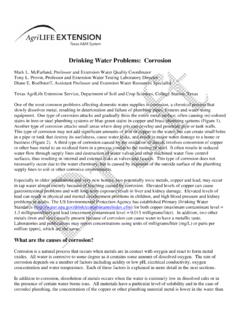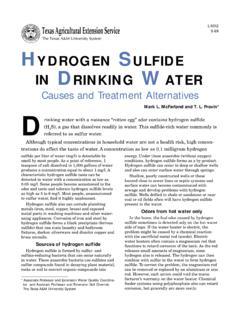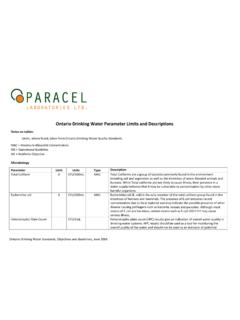Transcription of Where does my drinking water come from? - SMI Analytical
1 The South African Constitution states that everyone has the right to have access to an environment that is not harmful to their health or well-being. This includes a constant supply of clean, safe drinking water . Consumers may therefore have questions about the quality of their drinking water . This pamphlet was prepared to make information more widely available and encourage people to gain a better understanding of the processes required for the provision of safe drinking water for the communities of South Africa. What is safe drinking water ? Safe drinking water is water that is acceptable for humans to drink and use for other domestic purposes such as food preparation and bathing. drinking water should contain no harmful concentrations of chemical or micro-organisms, and should ideally have a pleasant appearance, taste and odour.
2 Access to safe drinking water is a basic human right and essential to people s health! Where does my drinking water come from? Our drinking water comes from two sources, surface water (rainfall and its runoff into rivers or dams), or groundwater ( water that has collected in underground stores or aquifers). These sources are sometimes close to the communities that they serve, or may be some distance away. Therefore, when thinking about Where drinking water is coming from, it is important not only to think of Where the water is abstracted, but rather about the whole catchment - the area over which rainfall is caught and drains into a water source. The raw water is abstracted from the source (dam, river or borehole) and transported to a water treatment works Where it is treated using different treatment processes.
3 After treatment, the water is stored in reservoirs or tanks and then distributed to users. Why is it necessary to treat drinking water ? water must meet certain basic requirements to make it fit for domestic uses. The most important requirement is that it must be safe to drink. Many The whole catchment draining into this dam needs to bemanaged properly to protect this source of drinking water July 2005 Page 2 drinking water Quality in South Africa A Consumer s Guidewater sources contain harmful micro-organisms or other substances in concentrations that make the water unsafe to drink. These micro-organisms and substances must therefore be removed from the water by means of treatment processes to make the water fit for consumption. When is it necessary to treat drinking water ?
4 It is not possible to tell if water from a particular source has to be treated simply by visual inspection of the water . The reason is that water may contain substances that are not visible, but can make the water unfit for drinking . It is therefore essential to take samples and analyse the water that is to be used as a source for domestic use. An assessment must then be done to determine whether the water is fit to drink as it is, or whether certain contaminants need to be removed and what treatment processes are required to remove these substances. How is my drinking water treated? The amount and type of water treatment varies with the source and quality of the water . Generally, surface waters require more treatment than groundwater, as surface waters are more likely to have been polluted by man.
5 When a water supplier abstracts water from a river or dam, it often contains suspended materials as well as contaminants. When the water gets to the treatment works, the water supplier will add chemicals called coagulants to the water so that the dirt forms clumps that settle to the bottom. The water then flows through a filter for removal of the smallest of the contaminants. After coagulation and filtration, water suppliers then add chlorine or another disinfectant to kill bacteria and other germs. Disinfection is the most important process in making the water safe to drink. Sometimes, water treatment is aimed at maintaining a desirable condition. For example, groundwater from deep boreholes may be clear and relatively free from bacteria, and may be able to be used without treatment.
6 But, this water may be contaminated during distribution or in the home. Disinfection, in this case, is aimed at reducing the risks associated with contamination during transport and storage. The more polluted the raw water source is, the more sophisticated the treatment required to produce high quality drinking water , and the higher the treatment costs. If you do not have access to safe drinking water , a variety of simple treatment methods can be used to treat raw water for domestic use. Examples of typical treatment methods include: Filtering the water through a cloth to remove suspended material; Boiling of water (for at least 10 minutes) to destroy micro-organisms that may cause disease; The raw water source needs to be sampled to assess its quality July 2005 Page 3 drinking water Quality in South Africa A Consumer s Guide Adding bleach to destroy micro-organisms (one teaspoon per 25 litres of water and allow to stand for at least 2 hours protected from sunlight); Adding chlorine granules (also known as HTH) to destroy micro-organisms (one teaspoon of granules per 200 litres of water and allow to stand for at least 2 hours protected from sunlight).
7 Exposing water to sunlight to destroy micro-organisms (in a transparent container, with a small airspace, shaken after filling and every hour thereafter, and left in direct sunlight for 6 hours). After treatment using these simple methods, water may be recontaminated if it is put into a dirty container or if it is not properly protected against pollution. Containers used for storing treated water must be properly washed and the containers covered to prevent contamination. NOTE: Care should be taken when boiling water to prevent injuries through burn wounds, and bleach and chlorine granules should be stored safely out of the reach of children. Bleach should also be kept in a dark bottle out of sunlight as its quality deteriorates with time.
8 What if I have special health needs? Sensitive or special needs groups include people who may have a particular medical problem which makes them more susceptible to poor water quality, including people living with HIV/AIDS, those undergoing chemotherapy, and transplant patients, amongst others. Infants, the frail elderly and pregnant women may also be more vulnerable to contaminants in drinking water than the general population. These sensitive groups may need to consider taking special precautions with their drinking water , including: Ensuring that drinking water taps are kept clean, and that animals do not have access to taps; Boiling drinking water if a drinking water problem is suspected, and Ensuring that containers used for storing drinking water are clean and are kept covered to prevent contamination.
9 Health and hygiene education is particularly important for sensitive groups, and can be effective in preventing water -related illnesses Who is responsible for safe drinking water in South Africa? The primary responsibility for the provision of safe drinking water rests with your water Services Authority (Local or District Municipality). water Services Authorities have a legal responsibility to: Monitor the quality of drinking water provided to consumers; Compare the results to national drinking water standards, and Communicate any health risks to consumers and appropriate authorities. July 2005 Page 4 drinking water Quality in South Africa A Consumer s Guideas described in the regulations to the water Services Act (No.)
10 108 of 1997) Compulsory National Standards for the Quality of Potable water : National drinking water standards are set to ensure the protection of public health. The South African National Standard (SANS) 241 drinking water Specification is the definitive reference on acceptable limits for drinking water quality in South Africa and provides guideline levels for a range of water quality characteristics. SANS 241 limits are comparable to international drinking water quality guidelines. Other important role-players responsible for safe drinking water are the Department of water Affairs and Forestry and the Department of Health. The Department of water Affairs and Forestry is responsible for managing South Africa s water resources for all its people, and also regulating the provision of drinking water by water Services Authorities.





